Abstract
Purpose
The aim of this study was to identify the risk factors of stoma re-creation after closure of diverting ileostomy in patients with rectal cancer who underwent low anterior resection (LAR) or intersphincteric resection (ISR) with loop ileostomy.
Methods
We retrospectively reviewed 520 consecutive patients with rectal cancer who underwent LAR or ISR with loop ileostomy from January 2005 to December 2014 at Chonnam National University Hwasun Hospital. Risk factors for stoma re-creation after ileostomy closure were evaluated.
Results
Among 520 patients with rectal cancer who underwent LAR or ISR with loop ileostomy, 458 patients underwent stoma closure. Among these patients, 45 (9.8%) underwent stoma re-creation. The median period between primary surgery and stoma closure was 5.5 months (range, 0.5–78.3 months), and the median period between closure and re-creation was 6.8 months (range, 0–71.5 months). Stoma re-creation was performed because of anastomosis-related complications (26, 57.8%), local recurrence (15, 33.3%), and anal sphincter dysfunction (3, 6.7%). Multivariate analysis showed that independent risk factors for stoma re-creation were anastomotic leakage (odds ratio [OR], 4.258; 95% confidence interval [CI], 1.814–9.993), postoperative radiotherapy (OR, 3.947; 95% CI, 1.624–9.594), and ISR (OR, 3.293; 95% CI, 1.462–7.417).
In patients with rectal cancer, sphincter-saving surgeries are increasing because of the improvement of the end-to-end anastomosis stapling devices, preoperative chemo-radiation therapy, and similar oncological outcomes to abdominoperineal resections (APR) [12345]. However, anastomotic leakage is the most unfavorable complication of sphincter-saving surgery because it is related with poor clinical outcomes, such as early postoperative morbidity and mortality [678]. Some studies have suggested that diverting stoma is a useful way of reducing the morbidity related with anastomotic [910]. In this regard, it is frequently used in sphincter-saving surgery. Furthermore, diverting stomas are usually performed i n ISR because of the concern regarding anal dysfunction [1112]. However, stomas negatively influence the patients' quality of life [2413141516]; hence, most of the stomas are thought to be temporary. Most of the patients may undergo reversal surgery, but some of them should experience stoma re-creation. Stoma re-creation can be a stressful event of both the surgeon and patient. However, few studies have been conducted regarding the predictable factors for stoma re-creation after primary closure of the temporary stoma.
The aim of this study was to identify the risk factors of stoma re-creation after primary reversal surgery of diverting ileostomy in patients with rectal cancer who underwent sphincter-saving surgery.
We retrospectively reviewed 520 patients who underwent LAR with diverting loop ileostomy (protective or after anastomotic leakage) due to rectal adenocarcinoma with Institutional Review Board approval from January 2005 to December 2014 at Chonnam University Hwasun Hospital (IRB no. CNUHH-2018-035). In addition, 458 patients underwent ileostomy closure surgery, whereas 62 patients remained as not closed. We enrolled 458 patients in our analysis (Fig. 1) and divided them into 2 groups: a stoma-free group and a stoma re-creation group. After placing the patients into 2 groups, the risk factors for stoma re-creation were evaluated.
Rectal cancer was determined by sigmoidoscopy and defined as a tumor with a lower border within 15 cm from the anal verge. Some patients had preoperative concurrent chemoradiation therapy, and postoperative chemotherapy or radiotherapy. All of the patients underwent LAR, and some underwent ISR. All rectal resections were performed with curative intent using total mesorectal excision.
The demographic data, including age, sex, American Society of Anesthesiologists physical status classification of preoperative physical status, body mass index (kg/m2), American Joint Committee on Cancer TNM tumor stage, tumor location of the upper, mid, or lower rectum, and type of rectal resection.
Anastomotic disruption, stricture, fistula, and proximal colonic ischemia were included in the anastomosis-related complications. Local recurrence is defined as radiological and histological evidence of recurrence at the anastomosis and pelvis.
Statistical analysis was performed with IBM SPSS Statistics ver. 21 (IBM Corp., Armonk, NY, USA). Chi-square test or Fisher exact test was used for univariate analyses for risk factors of secondary stomas. Multivariate analyses with logistic regression were performed to confirm the independent risk factors. Only parameters with a P-value of <0.15 were included in the multivariate analyses, and P-values of <0.05 were considered statistically significant.
This study included 458 patients who underwent stoma closure. Furthermore, the demographics of the patients are summarized in Table 1. The median period between primary surgery and stoma closure was 5.5 months (range, 0.5–78.3 months) and between closure and re-creation was 6.8 months (range, 0–71.5 months). After a median follow-up of 21.5 months (range, 3.6–125.3 months), 413 patients were confirmed to have no secondary stomas, whereas 45 patients required stoma re-creation. Of the 45 patients with secondary stoma (9.8%), 23 (51.1%) had loop T colostomies, 15 (33.3%) had end sigmoid colostomies (11 APR, 4 Hartmann surgeries), and 5 loop ileostomies (11.1%), and 2 end ileostomies (4.4%) (Table 2). Stoma re-creation was required because of anastomosis-related complications (26, 57.8%), local recurrence (15, 33.3%), anal dysfunction (3, 6.7%), and perforation of previous ileostomy (1, 2.2%) (Table 3). Among patients for stoma re-creation, 5 patients' stomas (11.1%) were closed, whereas 40 patients' stomas (88.9%) remained permanent.
The characteristics of the stoma-free and stoma re-creation groups are shown in Table 4, which shows that the risk factors of requiring a stoma re-creation were postoperative radiotherapy (P = 0.008) and anastomotic leakage (P = 0.009). Multivariate analysis showed that the independent risk factors for stoma recreation were the ISR (odds ratio [OR], 3.293; 95% confidence interval [CI], 1.462–7.417; P = 0.004), anastomotic leakage (OR, 4.258; 95% CI, 1.814–9.993; P = 0.001), and postoperative radiotherapy (OR, 3.947; 95% CI, 1.624%9.594) (Table 5).
Permanent stoma is one of the most unfavorable outcomes of rectal cancer surgery; thus, many attempts have been made to identify the risk factors of this issue. However, most of the aforementioned factors have been drawn from a lumped outcome; that is, permanent stoma without consideration of reversal of temporary stoma. Despite successful repair of primary diverting stoma, not only decreased quality of life of patients but also stoma re-creation ultimately may occur. Repeated laparotomies not only are stressful events to both patients and surgeons but also cause considerable economic burden. In this regard, we conducted an analysis with special emphasis on this patient group.
In the present study, 520 patients had LAR or ISR with loop ileostomy for curative intent of rectal cancer and 458 patients (89.1%) had primary stoma closure surgery. Of the patients with stoma closure, 9.8% (45 of 458) should have undergone stoma re-creation surgery finally, particularly for stoma re-creation, and 88.9% (40 of 45) were confirmed to have permanent stoma.
Previous studies have been conducted regarding permanent stoma in patients with rectal cancer. In these studies, nonclosure in primary stoma was found in 3.4%–23.6% [1718192021222324], stoma re-creation after primary closure was found in 0.4%–12.1% [17182021222324]. These results were consistent with the present study. These studies reported that the most common cause of permanent stoma was local recurrence, followed by anastomosis-related complications [1718192021222324]. Concurring with these studies, the present study indicated that the most common cause of re-creation was anastomosis-related complication (including anastomotic disruption, stricture, fistula, and proximal colonic ischemia) followed by local recurrence.
Kim et al. [21] reported that circumferential resection margin (CRM), radiotherapy, and anastomotic leakage were independent risk factors of secondary permanent stoma. Multivariate analyses of the current study showed that ISR (compared with non–sphincter-resecting LAR), postoperative radiotherapy, and anastomotic leakage on primary surgery are the independent risk factors for stoma re-creation.
Some studies compared ISR with non-sphincter-resecting LAR. Bretagnol et al. [12] reported that patients who underwent ISR have significantly worse continence and required more antidiarrheal drugs. Unlike the idea that sphincter dysfunction could be associated with ISR, in the present study, only 3 patients (6.7%) had stoma re-creation due to fecal incontinence. Instead, some studies have been conducted regarding the relationship between low anastomosis level and anastomotic leakage [71125]. Rullier et al. [11] reported that the risk of leakage was 6.5 times higher for anastomoses situated ≤5 cm from the anal verge than for those situated >5 cm. In the background of these studies, we supposed that ISR could induce a higher incidence of anastomotic leakage and that local recurrence could affect stoma re-creation rate.
Our study showed that postoperative radiotherapy was an independent risk factor of stoma re-creation. Sauer et al. [26] reported that postoperative chemo-radiation can induce anastomotic stricture compared with patients who underwent preoperative treatment only. Kollmorgen et al. [27] reported that 55 patients (93%) had normal stool continence in the nonradiation group, but only 18 patients (44%) in the group undergoing chemoradiotherapy reported normal continence. Holm et al. [28] also reported that adjuvant radiotherapy could increase intestinal obstruction and postoperative fistula. Concurring with these studies, we also found that postoperative radiotherapy causes adverse impact on the anastomosis site and neorectum. Of the 39 patients treated with postoperative radiotherapy, 9 patients (23.1%) had stoma recreation for anastomotic stricture (n = 3), dysfunction (n = 2), anastomotic disruption (n = 1), rectovaginal fistula (n = 1), and local recurrence (n = 2). In this regard, postoperative chemoradiotherapy should be selectively used for those who can most benefit from the treatment oncologically.
Anastomotic leakage is the most worrisome complication in sphincter-saving surgery for rectal cancer. Many studies reported that anastomotic leakage in primary surgery was an independent risk factor of permanent stoma [1718192021222324]. In the present study, we obtained a similar result. It is interesting that we first speculated that emergent stoma creation, when anastomotic leakage occurs in primary surgery, could influence stoma re-creation after closure, but it did not (Table 4). In patients with leakage, surgeons were maybe cautious in the closure of the primary stoma; hence, no difference was found in the stoma-free and re-creation groups.
The limitations of the current study include its retrospective and nonrandomized nature of the study; hence, this could provide selection bias. In addition, other significant factors that other studies reported as risk factors of anastomotic leakage [7112529], such as smoking and pulmonary problems, were not evaluated in the present study. Furthermore, we did not evaluate the anal function in an objective way, which could affect the stoma closure. Local recurrence was the major reason for stoma re-creation, and a relationship of CRM and local recurrence was found [2130], but CRM was not evaluated.
In conclusion, ISR, postoperative radiotherapy, and anastomotic leakage could be risk factors for stoma re-creation after primary closure of stoma in patients who underwent rectal cancer surgery with loop ileostomy. Surgeons should be more cautious in the closure of primary stoma in patients who have those risk factors.
References
1. Janjan NA, Khoo VS, Abbruzzese J, Pazdur R, Dubrow R, Cleary KR, et al. Tumor downstaging and sphincter preservation with preoperative chemoradiation in locally advanced rectal cancer: the M. D. Anderson Cancer Center experience. Int J Radiat Oncol Biol Phys. 1999; 44:1027–1038. PMID: 10421535.

2. Kinoshita Y, Nokes KM, Kawamoto R, Kanaoka M, Miyazono M, Nakao H, et al. Health-related quality of life in patients with lower rectal cancer after sphincter-saving surgery: a prospective 6-month follow-up study. Eur J Cancer Care (Engl). 2017; 26:e12417.

3. Rullier E, Laurent C, Bretagnol F, Rullier A, Vendrely V, Zerbib F. Sphincter-saving resection for all rectal carcinomas: the end of the 2-cm distal rule. Ann Surg. 2005; 241:465–469. PMID: 15729069.
4. Allal AS, Bieri S, Pelloni A, Spataro V, Anchisi S, Ambrosetti P, et al. Sphincter-sparing surgery after preoperative radiotherapy for low rectal cancers: feasibility, oncologic results and quality of life outcomes. Br J Cancer. 2000; 82:1131–1137. PMID: 10735495.

5. Wibe A, Syse A, Andersen E, Tretli S, Myrvold HE, Søreide O, et al. Oncological outcomes after total mesorectal excision for cure for cancer of the lower rectum: anterior vs. abdominoperineal resection. Dis Colon Rectum. 2004; 47:48–58. PMID: 14719151.

6. Mileski WJ, Joehl RJ, Rege RV, Nahrwold DL. Treatment of anastomotic leakage following low anterior colon resection. Arch Surg. 1988; 123:968–971. PMID: 3395240.

7. Karanjia ND, Corder AP, Bearn P, Heald RJ. Leakage from stapled low anastomosis after total mesorectal excision for carcinoma of the rectum. Br J Surg. 1994; 81:1224–1226. PMID: 7953369.

8. Bokey EL, Chapuis PH, Fung C, Hughes WJ, Koorey SG, Brewer D, et al. Postoperative morbidity and mortality following resection of the colon and rectum for cancer. Dis Colon Rectum. 1995; 38:480–486. PMID: 7736878.

9. Chude GG, Rayate NV, Patris V, Koshariya M, Jagad R, Kawamoto J, et al. Defunctioning loop ileostomy with low anterior resection for distal rectal cancer: should we make an ileostomy as a routine procedure? A prospective randomized study. Hepatogastroenterology. 2008; 55:1562–1567. PMID: 19102343.
10. Huser N, Michalski CW, Erkan M, Schuster T, Rosenberg R, Kleeff J, et al. Systematic review and meta-analysis of the role of defunctioning stoma in low rectal cancer surgery. Ann Surg. 2008; 248:52–60. PMID: 18580207.
11. Rullier E, Laurent C, Garrelon JL, Michel P, Saric J, Parneix M. Risk factors for anastomotic leakage after resection of rectal cancer. Br J Surg. 1998; 85:355–358. PMID: 9529492.

12. Bretagnol F, Rullier E, Laurent C, Zerbib F, Gontier R, Saric J. Comparison of functional results and quality of life between intersphincteric resection and conventional coloanal anastomosis for low rectal cancer. Dis Colon Rectum. 2004; 47:832–838. PMID: 15108027.

13. Prieto L, Thorsen H, Juul K. Development and validation of a quality of life questionnaire for patients with colostomy or ileostomy. Health Qual Life Outcomes. 2005; 3:62. PMID: 16219109.

14. Fucini C, Gattai R, Urena C, Bandettini L, Elbetti C. Quality of life among five-year survivors after treatment for very low rectal cancer with or without a permanent abdominal stoma. Ann Surg Oncol. 2008; 15:1099–1106. PMID: 18181002.

15. Nugent KP, Daniels P, Stewart B, Patankar R, Johnson CD. Quality of life in stoma patients. Dis Colon Rectum. 1999; 42:1569–1574. PMID: 10613475.

16. Gooszen AW, Geelkerken RH, Hermans J, Lagaay MB, Gooszen HG. Quality of life with a temporary stoma: ileostomy vs. colostomy. Dis Colon Rectum. 2000; 43:650–655. PMID: 10826426.
17. Lindgren R, Hallbook O, Rutegard J, Sjodahl R, Matthiessen P. What is the risk for a permanent stoma after low anterior resection of the rectum for cancer? A six-year follow-up of a multicenter trial. Dis Colon Rectum. 2011; 54:41–47. PMID: 21160312.

18. Gessler B, Haglind E, Angenete E. Loop ileostomies in colorectal cancer patients: morbidity and risk factors for nonreversal. J Surg Res. 2012; 178:708–714. PMID: 22940030.
19. Chun LJ, Haigh PI, Tam MS, Abbas MA. Defunctioning loop ileostomy for pelvic anastomoses: predictors of morbidity and nonclosure. Dis Colon Rectum. 2012; 55:167–174. PMID: 22228160.
20. Anderin K, Gustafsson UO, Thorell A, Nygren J. The effect of diverting stoma on long-term morbidity and risk for permanent stoma after low anterior resection for rectal cancer. Eur J Surg Oncol. 2016; 42:788–793. PMID: 27132071.

21. Kim MJ, Kim YS, Park SC, Sohn DK, Kim DY, Chang HJ, et al. Risk factors for permanent stoma after rectal cancer surgery with temporary ileostomy. Surgery. 2016; 159:721–727. PMID: 26490725.

22. Lee CM, Huh JW, Park YA, Cho YB, Kim HC, Yun SH, et al. Risk factors of permanent stomas in patients with rectal cancer after low anterior resection with temporary stomas. Yonsei Med J. 2015; 56:447–453. PMID: 25683994.

23. Lim SW, Kim HJ, Kim CH, Huh JW, Kim YJ, Kim HR. Risk factors for permanent stoma after low anterior resection for rectal cancer. Langenbecks Arch Surg. 2013; 398:259–264. PMID: 23224628.

24. Pan HD, Peng YF, Wang L, Li M, Yao YF, Zhao J, et al. Risk factors for nonclosure of a temporary defunctioning ileostomy following anterior resection of rectal cancer. Dis Colon Rectum. 2016; 59:94–100. PMID: 26734966.

25. Lee WS, Yun SH, Roh YN, Yun HR, Lee WY, Cho YB, et al. Risk factors and clinical outcome for anastomotic leakage after total mesorectal excision for rectal cancer. World J Surg. 2008; 32:1124–1129. PMID: 18259805.

26. Sauer R, Becker H, Hohenberger W, Rodel C, Wittekind C, Fietkau R, et al. Preoperative versus postoperative chemoradiotherapy for rectal cancer. N Engl J Med. 2004; 351:1731–1740. PMID: 15496622.

27. Kollmorgen CF, Meagher AP, Wolff BG, Pemberton JH, Martenson JA, Illstrup DM. The long-term effect of adjuvant postoperative chemoradiotherapy for rectal carcinoma on bowel function. Ann Surg. 1994; 220:676–682. PMID: 7979617.

28. Holm T, Singnomklao T, Rutqvist LE, Cedermark B. Adjuvant preoperative radiotherapy in patients with rectal carcinoma. Adverse effects during long term follow-up of two randomized trials. Cancer. 1996; 78:968–976. PMID: 8780533.

29. Akasu T, Takawa M, Yamamoto S, Yamaguchi T, Fujita S, Moriya Y. Risk factors for anastomotic leakage following intersphincteric resection for very low rectal adenocarcinoma. J Gastrointest Surg. 2010; 14:104–111. PMID: 19841989.

30. Adam IJ, Mohamdee MO, Martin IG, Scott N, Finan PJ, Johnston D, et al. Role of circumferential margin involvement in the local recurrence of rectal cancer. Lancet. 1994; 344:707–711. PMID: 7915774.





 PDF
PDF ePub
ePub Citation
Citation Print
Print



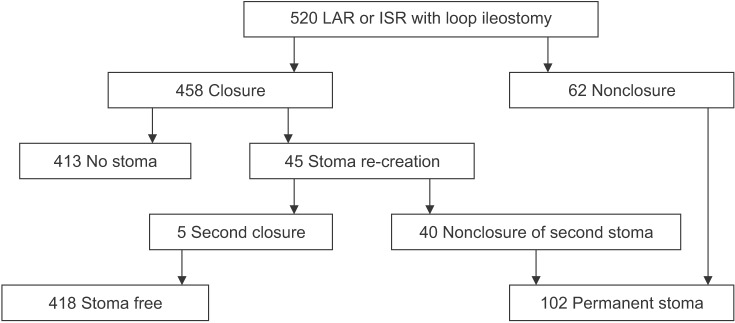
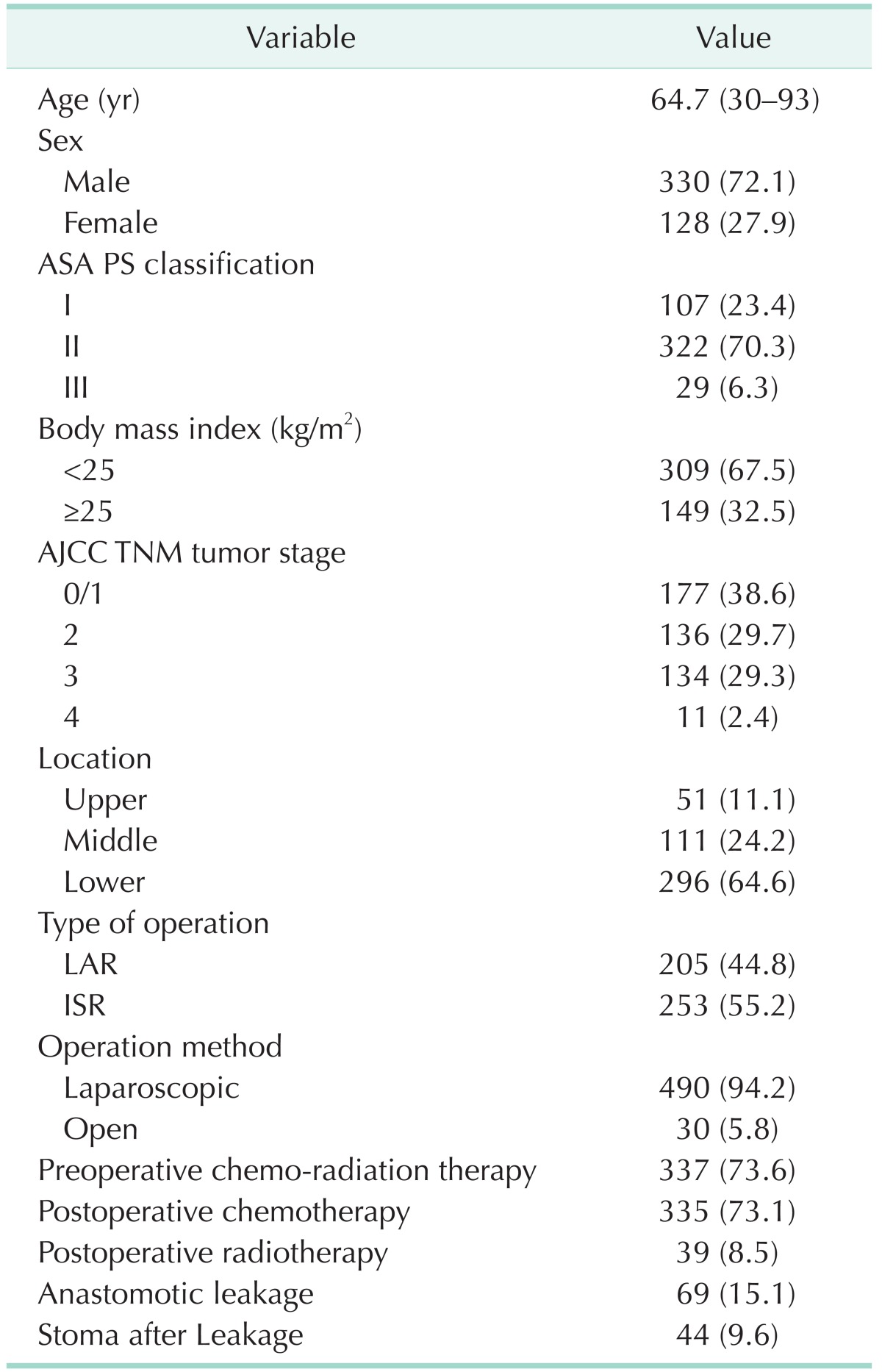
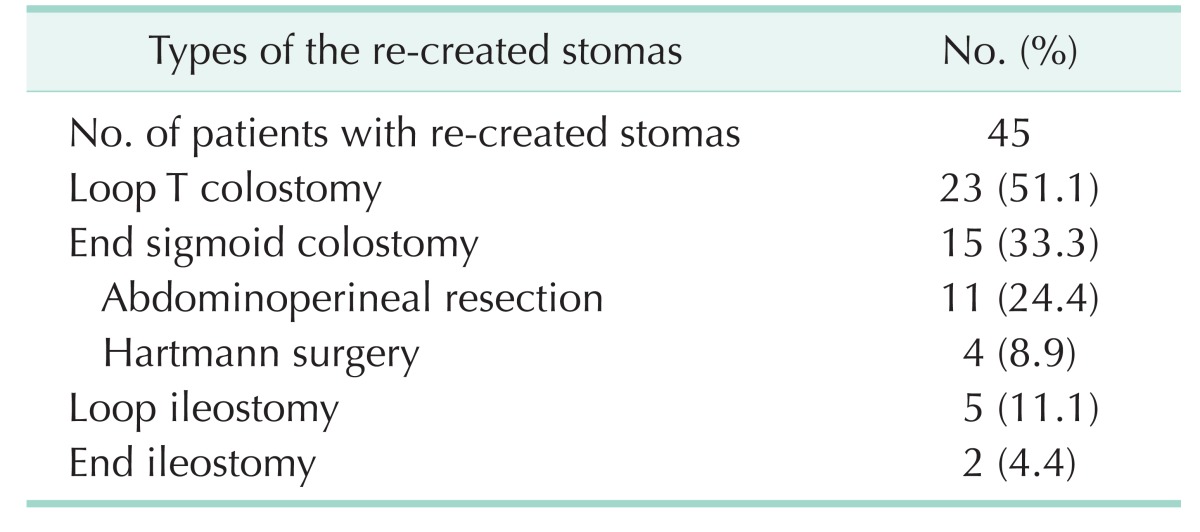
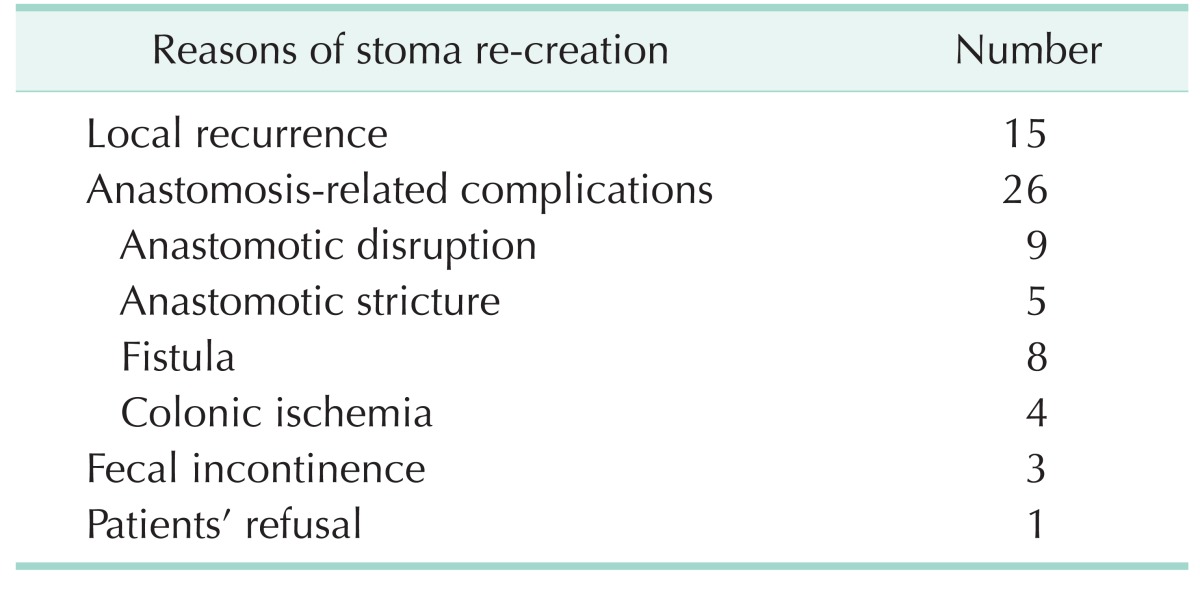
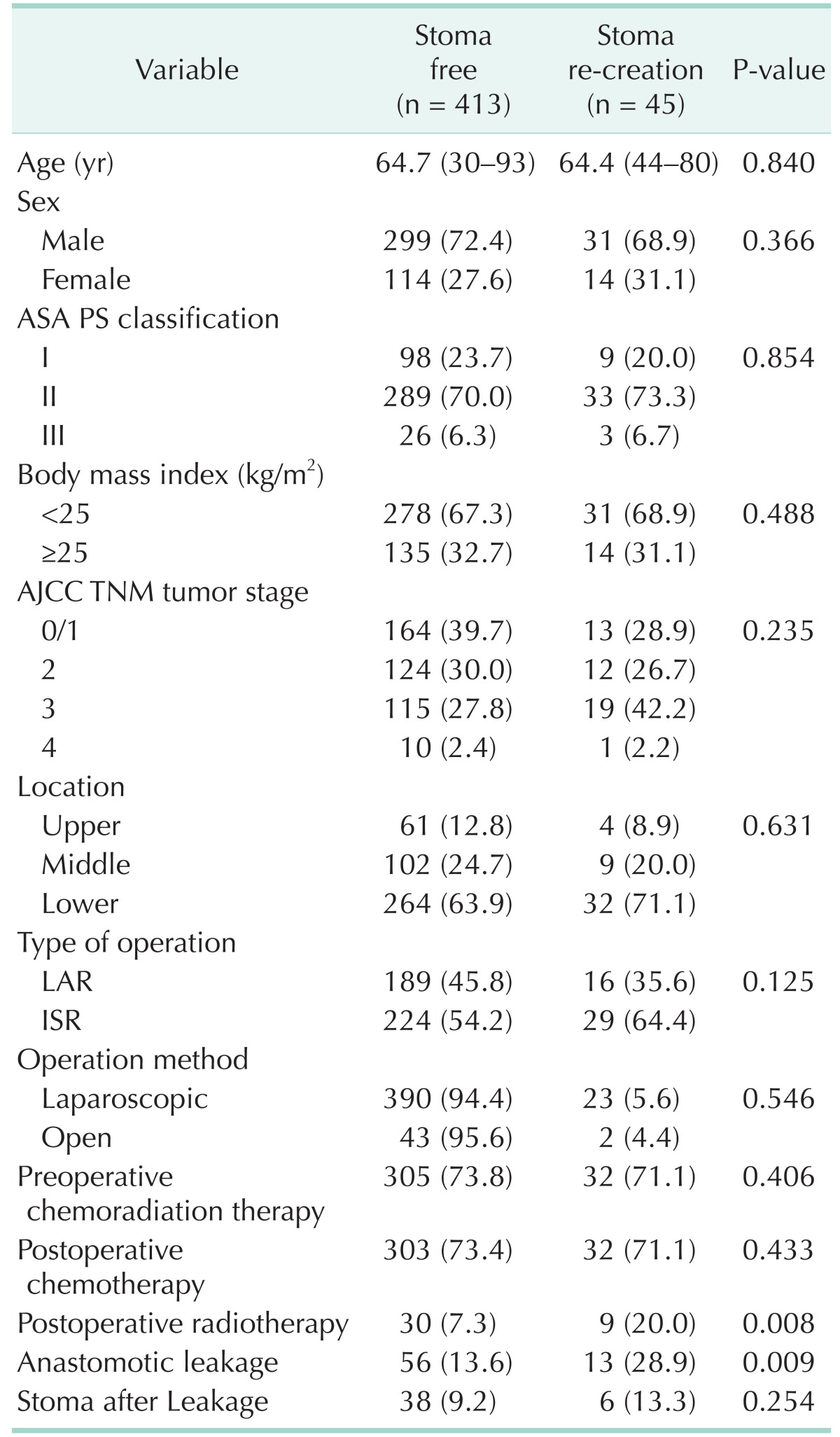

 XML Download
XML Download